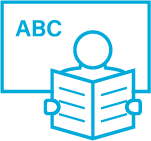Early Childhood Reading Sessions Support Reading Skills

The present study focused on how does the young child become excited about reading. The number of books at home, library visits, and the type of reading modelled by the parents are all important, as well as shared reading with the child. However, the child’s independent reading is the most important thing.
Authors: Marja-Kristiina Lerkkanen, Jenni Salminen, & Eija Pakarinen
Source: Lerkkanen, M.-K., Salminen, J., & Pakarinen, E. (2018). Varhaislapsuuden lukuhetket tukevat lukutaitoa. Onnimanni, 1-2, 20-26.
How does the young child become excited about reading? According to our research, the home environment has an effect. The number of books at home, library visits, and the type of reading modelled by the parents are all important, as well as shared reading with the child. However, the child’s independent reading is the most important thing.
- The home literacy environment is important for the child.
- A rich literacy environment provides opportunities to get to know the language.
- Finnish parents value reading. For the child, a bedtime story is read, library visits are shared, and books are available. Thus, the child is exposed to language and reading.
What is the home literacy environment (HLE)?
- This refers to texts, letters, and reading-related resources and opportunities.
- This might include shared reading, the number of children’s books at home, the number of library visits, and the type of reading modelled by the parents.
- An informal home reading environment includes parent’s behaviour that indirectly provide the child with reading models.
- A formal home reading environment includes parent’s direct acts when they direct the child’s attention to texts and reading or teach reading directly.

The study
Here, two studies are presented about the HLE of children aged 2–3 years and 6 years old and their pre-reading skills.
Participants in the first study were 208 parents who reported their HLE practices with their 2–3-year old children. The second study consisted of 536 children aged 6 years old and 362 parents who reported the HLE and child’s pre-reading skills.

Findings
- Most parents (>80%) read to their children at home. This is important for the child’s vocabulary, attention, concentration, and motivation.
- Almost all children browsed books by themselves.
- The children aged 2–3 years looked at books more than television or mobile devices. However, those aged 6 years watched television and mobile devices more than they browsed books.
- Almost all children visited libraries. The 6 years olds visited more often than the 2–3-year olds. Such visits are related to positive attitudes and motivation towards reading.
- About half of the 2–3-year olds had more than 10 children’s books in their home, whilst 6-year olds had more than 50 books.

How parents can support their child’s reading skill development
- Read to their child.
- Read with their child.
- Listen when their child reads.
- Visit the library together with their child.
What are the benefits of reading to a child?
- The child learns to notice the relationship between the spoken and written language.
- The child learns to notice the relationship between text and their own experiences.
- The child develops awareness of the structure of written language.
- The child develops vocabulary and comprehension of language.
- The child develops listening comprehension skills.
- The child learns the basics of reading, and may even actually learn to read.